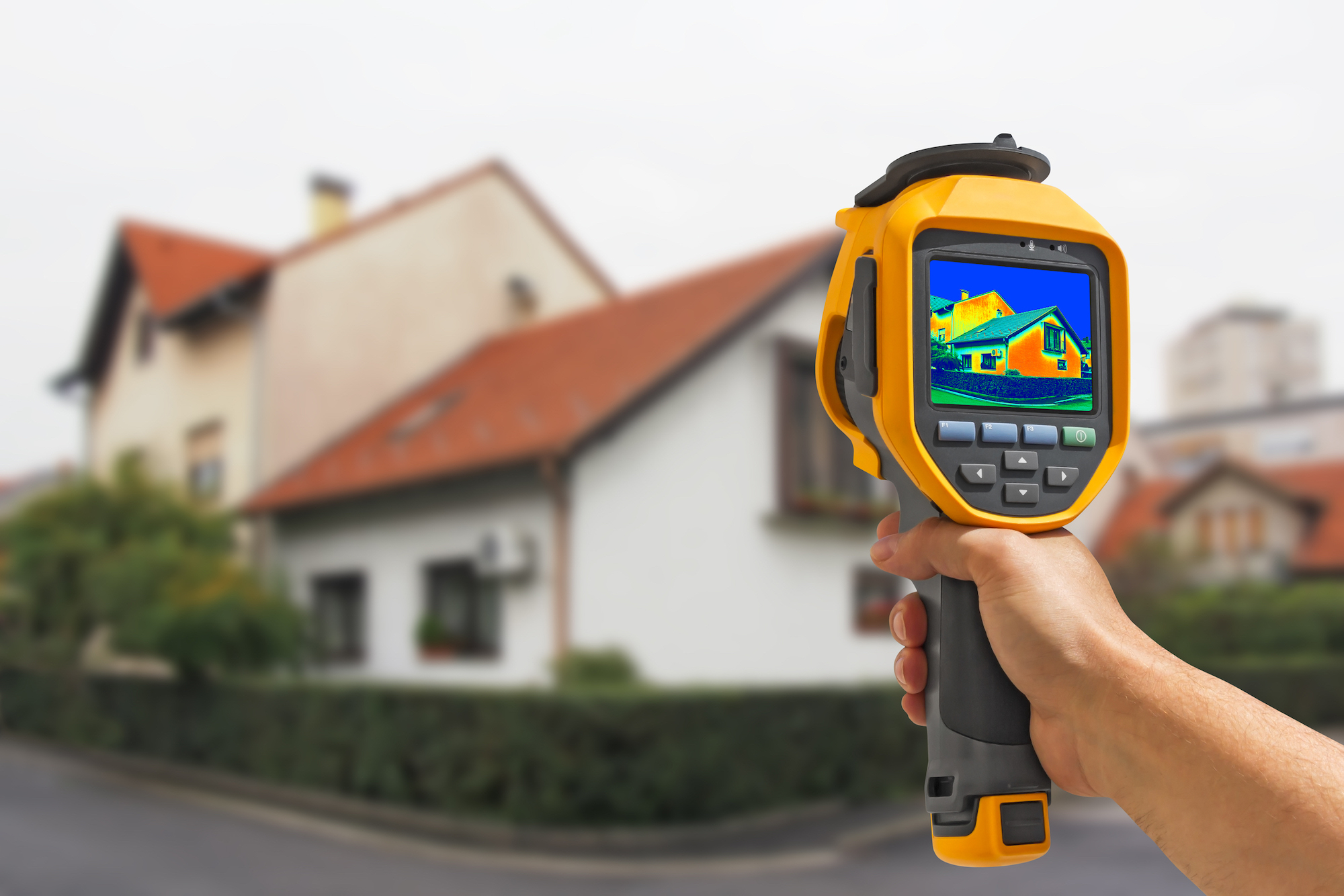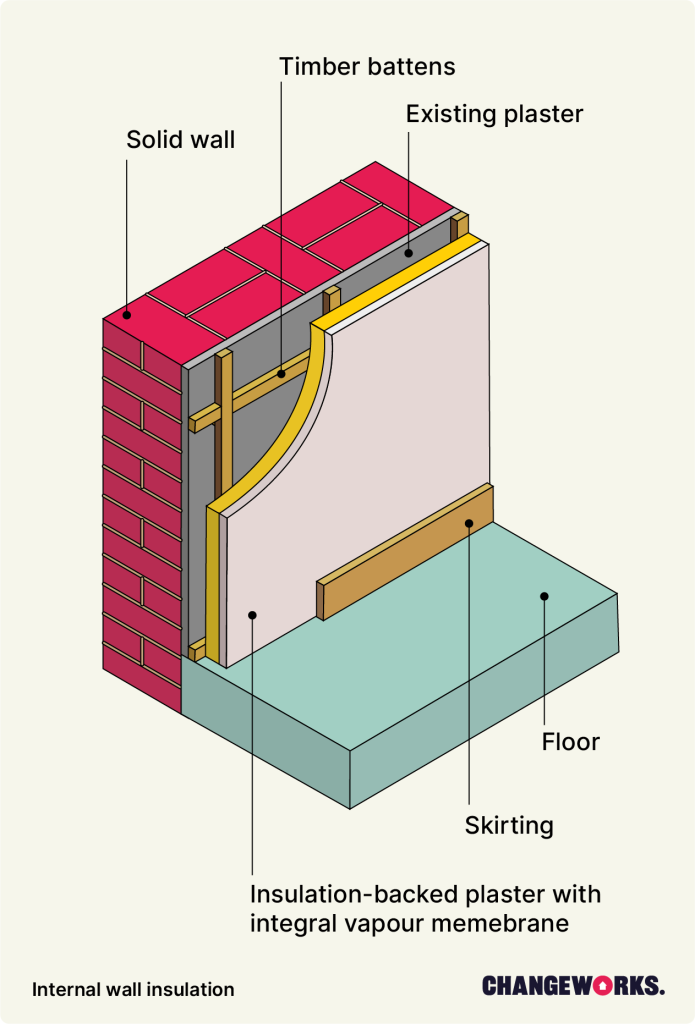Internal wall insulation
Internal wall insulation is like putting a vest on your home. The insulation is added to the interior of your property, and can be installed in several ways.

Are you unsure what type of walls your home has? Your Energy Performance Certificate (EPC) should be able to tell you. You can check this on the Scottish EPC Register.
The best way to improve the energy efficiency of your home’s solid (non-cavity) walls is by adding solid wall insulation. There are two ways to insulate a solid wall:
- Internal wall insulation.
- External wall insulation.
With internal wall insulation, installers add insulation to the inside of your exterior walls. So, if external wall insulation is like putting a jacket on your property, internal wall insulation is more like putting on a thick vest.

FAQs – Internal wall insulation
If you’ve been offered the opportunity to have internal wall insulation installed at your home, these FAQs should answer any questions you may have.
The installation of the insulation typically takes between 3 to 5 days. The contractor will endeavor to ensure there is as little mess as possible. The insulation boards will be prepared outside of your property to minimise dust and mess. Furniture and floor coverings will be covered throughout the installation of the insulation and any tools and materials will be removed by the contractor at the end of the day. Please note this can be an intrusive process due to the nature of the work.
Yes, the room the insulation is being installed in will be left in a habitable condition at the end of each working day.
There will be some drilling as the boards are affixed to the walls and there will be some dust. The contractor will endeavor to keep this to a minimum.
No, you do not need to be at home during the installation process. Access to your home can be arranged with the contractor’s Site Manager or Resident Liaison Officer.
During the installation, electrical sockets and aerials will be removed and reinstated. The electricity supply to the affected rooms will be turned off but the contractor will ensure that power to the kitchen will be kept on.
The electricity will only be turned off on the first day of the works and power will be switched back on at the end of the first day. If radiators are removed for the purposes of the installation, the contractor will endeavor to have these reinstated as soon as possible after the plaster works are completed.
Where agreed at the Survey stage, all insulated walls will be painted white by the contractor and other decorative features i.e cornicing may be replaced. This will be discussed at survey.
Any existing damp would need to be treated before the installation of the insulation unless the cause of damp is confirmed at the technical survey as being condensation damp, as this would benefit from the installation of internal wall insulation.
We are offering internal wall insulation to suitable households. Households who opt to have internal wall insulation installed will also be assessed for further energy efficiency measures including secondary glazing, draught proofing, loft and potentially underfloor insulation.
The surveyor will assess the suitability of your home for these measures and you will be offered a package of measures once the survey is complete.
Yes, the insulation will include a 25-year guarantee.
The amount of funding available to each household varies depending on factors such as house type and the circumstances of those living in the property.
The internal wall insulation is the primary measure and must be installed to have the option of installing additional measures at a subsidised cost.
Property sizes and the number of walls insulated in each property will vary, this will affect how much it costs to install the insulation and in turn the cost to install additional energy efficiency measures.
The proposed insulation system is sufficiently safe that the use of the system is unrestricted by the Scottish building regulations. and is one of the most effective and widespread boards used for this type of insulation.
Yes, careful consideration should always be taken about the weight of an item being hung on the wall and as with all wall hung objects, a solid fixing should always be sought.
Information on the type of fixing to use for different loads will be covered in the contractors’ handover pack provided to the householder on completion of the installation.
Unfortunately, the contractor would be unable to refit wall mounted televisions due to insurance purposes but would be happy to offer advice to each resident on how to carry out this work.
The installers will require full access to your property during the programmed dates of work as several items of work such as plastering, and decoration will require visits and drying time between visits.
This is generally down to the choice of the resident. The contractor would recommend that any floor coverings are cut back accordingly to ensure that all the external walls are fully insulated, and that future carpet or flooring renewals do not unnecessarily disturb the insulation work.
Local Authorities are awarded grant funding from the Scottish Governments Energy Efficient Scotland: Area Based Schemes (EES ABS). This grant funding is available to support private householders to improve the energy efficiency of their homes.
The financial support available through EES: ABS allows us to offer these measures at a substantially reduced cost or for free.
As part of this project, the appointed contractor would prepare a pre and post install EPC and a copy of these certificates will be made available to you. Please note that if you are a council or housing association tenant, the document would be provided to them in the first instance.
Have a chat with an energy advisor at Home Energy Scotland on 0808 808 2282 for advice on ways to save energy and money in your home.